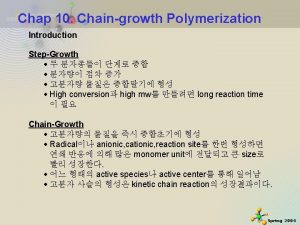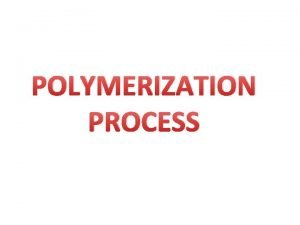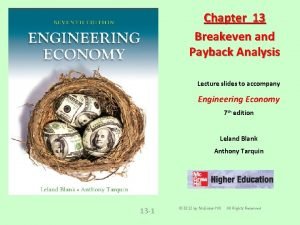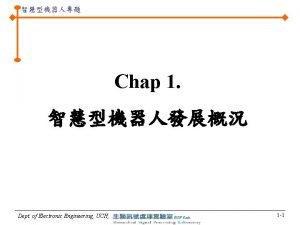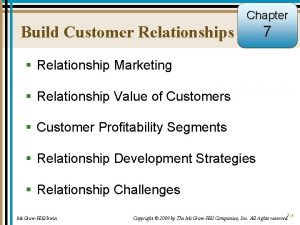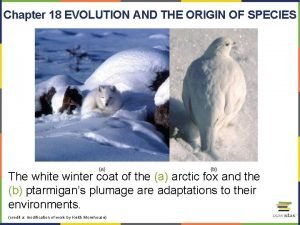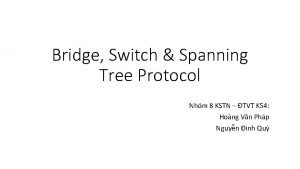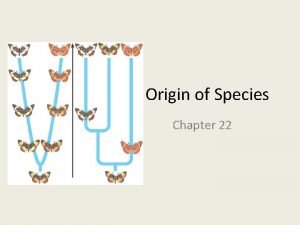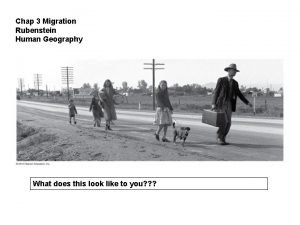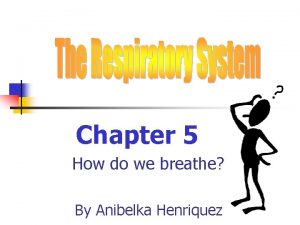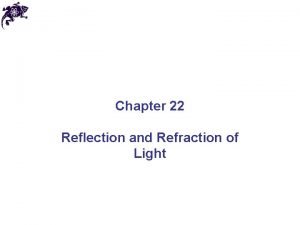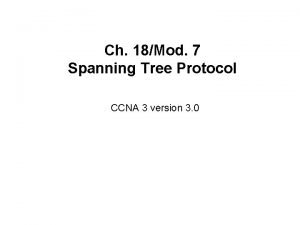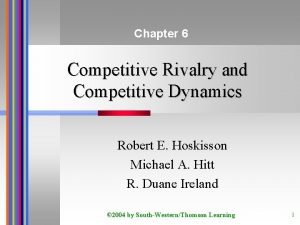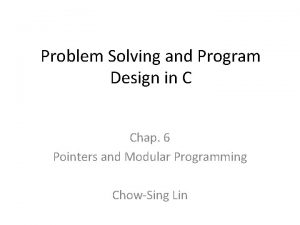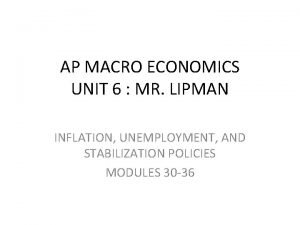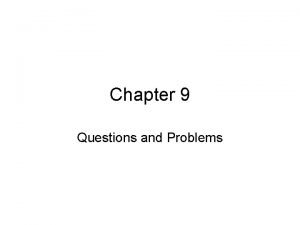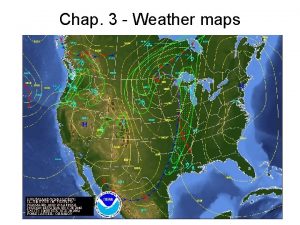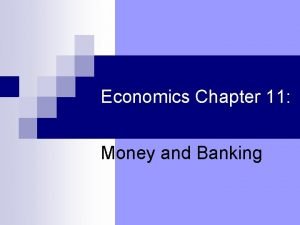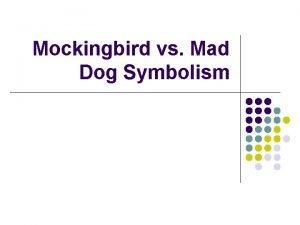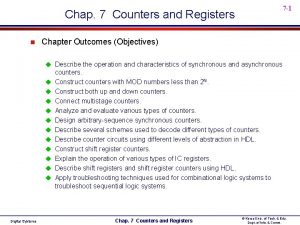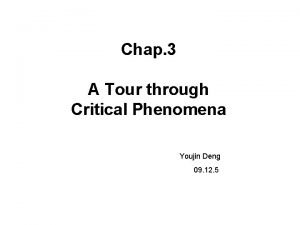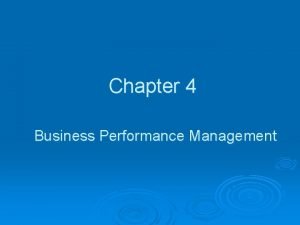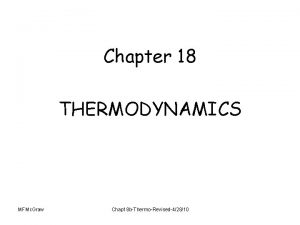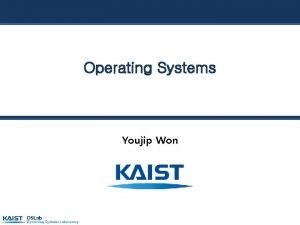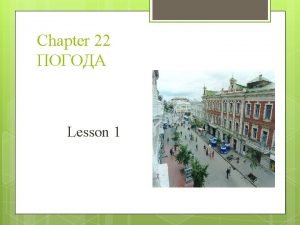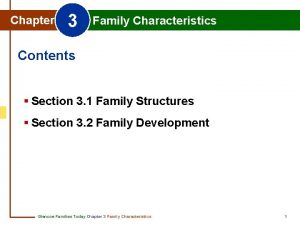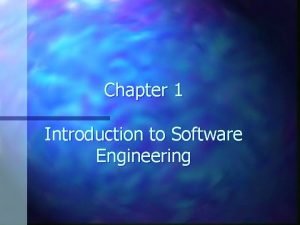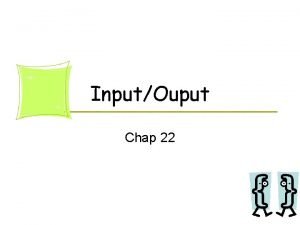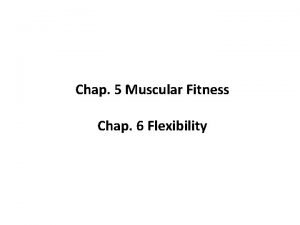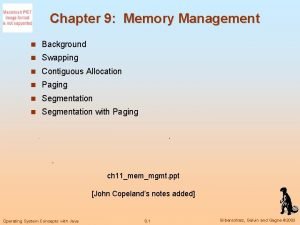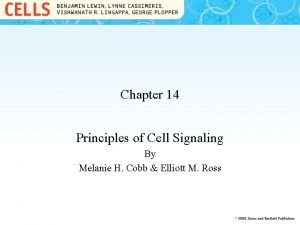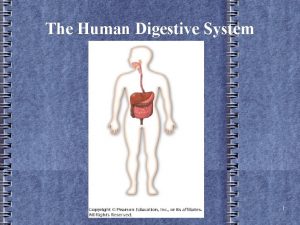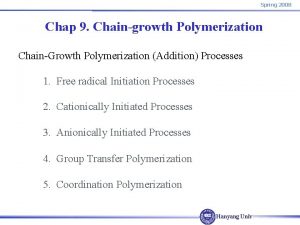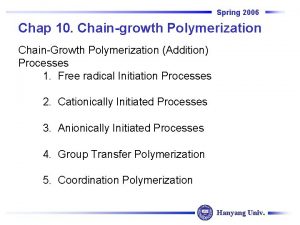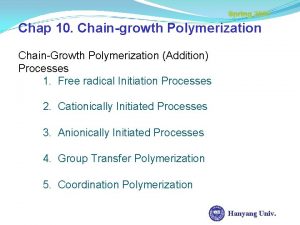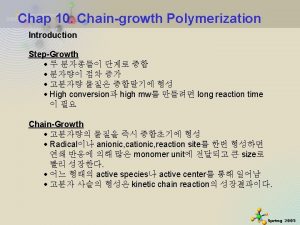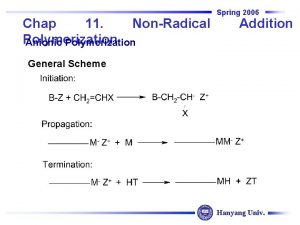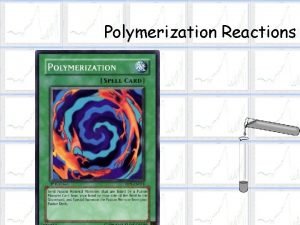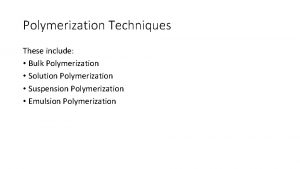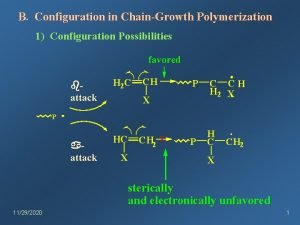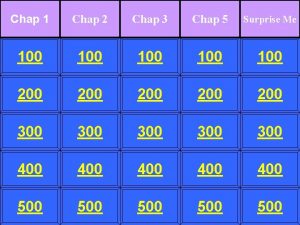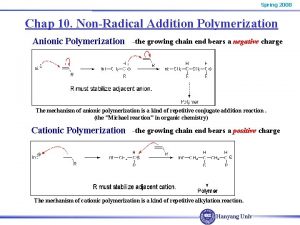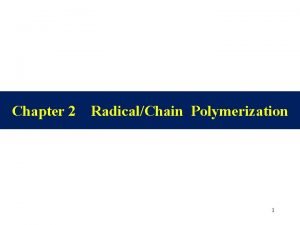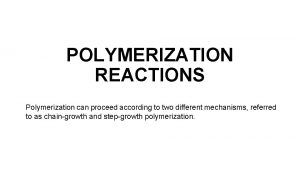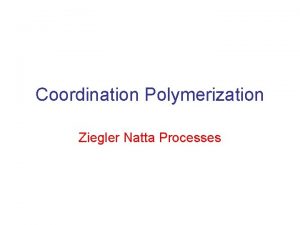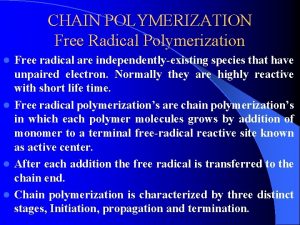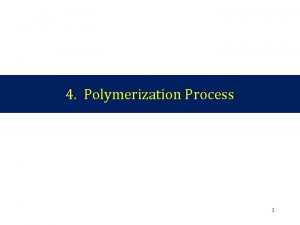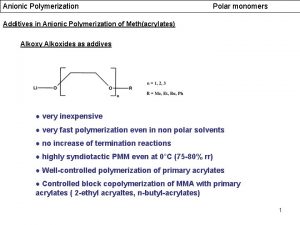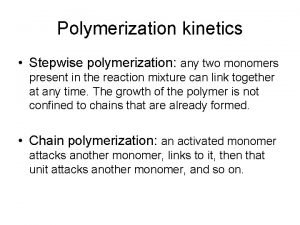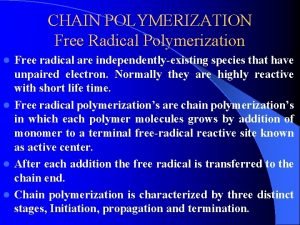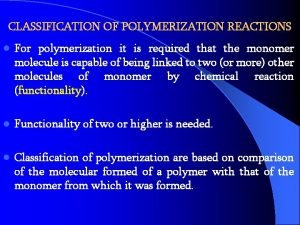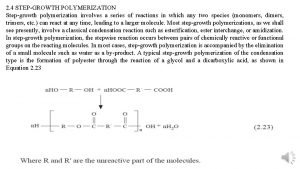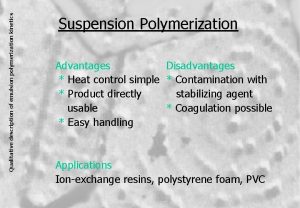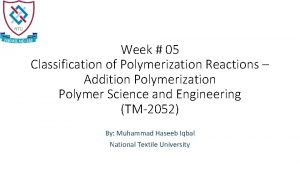Spring 2008 Chap 9 Chaingrowth Polymerization ChainGrowth Polymerization





























![Spring 2008 Kinetic Chain Reaction [M ] elimination methods Steady-State Assumption Radical concentration increases Spring 2008 Kinetic Chain Reaction [M ] elimination methods Steady-State Assumption Radical concentration increases](https://slidetodoc.com/presentation_image/13923fb49b580a7b8b436220d791639e/image-30.jpg)
![Spring 2008 Kinetic Chain Reaction Mostly in case of f<1 system → [I 2]1/2 Spring 2008 Kinetic Chain Reaction Mostly in case of f<1 system → [I 2]1/2](https://slidetodoc.com/presentation_image/13923fb49b580a7b8b436220d791639e/image-31.jpg)














![Spring 2008 Ceiling Temperature Polymer-Depolymerization Equilibria k sec-1 kdp kp[M]- kdp Tc : No Spring 2008 Ceiling Temperature Polymer-Depolymerization Equilibria k sec-1 kdp kp[M]- kdp Tc : No](https://slidetodoc.com/presentation_image/13923fb49b580a7b8b436220d791639e/image-46.jpg)



- Slides: 49

Spring 2008 Chap 9. Chain-growth Polymerization Chain-Growth Polymerization (Addition) Processes 1. Free radical Initiation Processes 2. Cationically Initiated Processes 3. Anionically Initiated Processes 4. Group Transfer Polymerization 5. Coordination Polymerization Hanyang Univ.

Spring 2008 Chain-Growth Polymerization 1. Only growth reaction adds repeating units one at a time to the chain 2. Monomer concentration decreases steadily throughout the reaction 3. High Molecular weight polymer is formed at once; polymer molecular weight changes little throughout the reaction. 4. Long reaction times give high yields but affect molecular weight little. 5. Reaction mixture contains only monomer, high polymer, and about 10 -8 part of growing chains. Step-Growth Polymerization 1. Molecular weight increases steadily. 2. High molecular weight polymers are found at the end. 3. Long reaction time needs to synthesize high conversion and high molecular weight. Hanyang Univ.

Spring 2008 Chain Growth Polymerization (1) Initiation kd : Initiator decomposition rate constant I -4 -6 : 10 ~ 10 L/mole sec Bond Energy = 46 kcal/mole Heat (60ºC) UV kd AIBN Primary radical Unstable radical Hanyang Univ.

Spring 2008 Chain Growth Polymerization (2) Propagation (Repetition of similar reaction) kp : 102 ~ 104 L/mole sec (much faster than step-growth polymerization) Hanyang Univ.

Spring 2008 Chain Growth Polymerization (3) Termination (a) Coupling or combination Hanyang Univ.

Spring 2008 Chain Growth Polymerization (3) Termination (b) Disproportionation kt=ktc+ktd 106 ~ 108 L/mole sec Hanyang Univ.

Spring 2008 Chain Growth Polymerization (4) Chain Transfer Physical chain length Monomer, Polymer, Solvent or Chain transfer agent Kinetic chain length Hanyang Univ.

Spring 2008 Chain Growth Polymerization Kinetic Chain Length : kinetic chain length υ of a radical chain polymerization is defined as the average number of monomer molecules consumed (polymerized) per each radical, which initiates a polymer chain. ex) Monomer # 4000 Radical 1, 2, 3, 4 Disproportionation υ =4, 000/4 =1, 000 Determined by steps 1, 2, 3. (Initiation, propagation, and termination) (No chain transfer) Physical Chain Length : This condition contains Step 1, 2, 3, 4. Hanyang Univ.

Spring 2008 Kinetic Chain Reaction Non-Polymerization Reaction Peroxide induced Bromination of Toluene 1) Initiation Two types of reaction R-O-O-R R-O • + Br 2 R-O • + ФCH 3 2 RO • ROBr + Br • ROH + ФCH 2 • (1) (2) (3) Two radicals and two kinetic chains are formed by decomposition of each ROOR molecules Hanyang Univ.

Spring 2008 Kinetic Chain Reaction 2) Propagation Br • + ФCH 3 HBr + ФCH 2 (4) ФCH 2 • + Br 2 ФCH 2 Br + Br • (5) Two special features The number of active species is fixed. Same reactions are repeated during the kinetic chain reaction. Hanyang Univ.

Spring 2008 Kinetic Chain Reaction 3) Termination 2 Br • 2 ФCH 2 • + Br • Br 2 ФCH 2 Ф ФCH 2 Br + Br • Net Effect of Kinetic Chain Reaction: One ROOR molecule can cause formation of Br 2, CH 2 Br, HBr, ‥. Hanyang Univ.

Spring 2008 Kinetic Chain Reaction Comparison between Chain Polymerization & Chain Reaction Chain reaction Ri = Rt Reaction Rate Steady state Time Induction period In proportion to the O 2 concentration Hanyang Univ.

Spring 2008 Kinetic Chain Reaction v. In the case of Chain reaction, there are induction periods, due to the existence of inhibitor. v. When an active center is formed, the reaction rate would be faster and then go to steady state. v. The whole reaction rate is reaching a plateau region. v. After that, reaction rate decreases due to a loss of monomers or initiators. Linear Chain-Growth: Polymer of high DPn found easily in early reaction Linear Step-Growth: high extent of reaction value required to obtain high DPn Hanyang Univ.

Spring 2008 Kinetic Chain Reaction Comparison Free Radical Reaction & Ionic Reaction - Ionic Initiation – multiple bond addition, ring opening polymerization - Radical Initiation – Ring-opening polymerization is not initiated. For the cationic initiation, it will not be free radical. isobutylene Ex) Because of resonance stability Hanyang Univ.

Spring 2008 Kinetic Chain Reaction Comparison between Free Radical Reaction & Ionic Reaction Hanyang Univ.

Spring 2008 Kinetic Chain Reaction Comparison between Free Radical Reaction & Termination Step of Ionic Reaction A) Free Radical Termination Two molecules involved = bimolecular reaction Hanyang Univ.

Spring 2008 Kinetic Chain Reaction B) Cationic Termination Anionic capture is similar to combination of free radical reaction. But, this reaction can’t include increasing of MW because of unimolecular reaction Hanyang Univ.

Spring 2008 Kinetic Chain Reaction The proton release is similar to disproportination of free radical. . But, one chain joins in the reaction unimolecular reaction C) Anionic Termination Hanyang Univ.

Spring 2008 Kinetic Chain Reaction Hanyang Univ.

Spring 2008 Kinetic Chain Reaction Free Radical Initiated Polymerization of Unsaturated monomers Kinetic Scheme Initiation Two step sequence-Both enter into overall rate 1. Initiator decomposition I 2 kd 2 I 2. Addition of Initiator fragment to the monomer, Initiation of Chain growth. I +M ki IM Primary radical species The efficiency of Initiator - Determined by competition of desired reaction and side reaction Generally, 0. 5 << f << 1 Hanyang Univ.

Spring 2008 Kinetic Chain Reaction A. Cage Effect –primary recombination Initiator fragments surrounded by restricting cage of solvent Ex) (acetyl peroxide) Hanyang Univ.

Spring 2008 Kinetic Chain Reaction I) Recombination possible I 2 2 I II) If elimination reaction occurs while the free radical in-cage, Formation of stable molecules due to Radical combination. And formation of Inactive Species. Hanyang Univ.

Spring 2008 Kinetic Chain Reaction B. Induced Decomposition –Secondary combination I) Through Radical attack on peroxide molecules R + R -O-O-R Finally, RH + R OOR R =O + R O ROR + R O Total number of radical does not change, but among them half molecules were wasted. II) Chain Transfer to Solvent (In this case, since just one radical was obtained half molecules were wasted. ) Hanyang Univ.

Spring 2008 Kinetic Chain Reaction III) Reaction with Chain Radical I. + M IMn. + IMn. I 2 IMn. I + I. Since not all Molecules participate in the initiation → Efficiency factor f: Initiator Efficiency = mole fraction of initiator fragments that actually initiate polymer chains. 0. 5 < f < 1. 0 Hanyang Univ.

Spring 2008 Kinetic Chain Reaction C. Reaction Rate by convention, two radical formation. If [M ] is representative for the concentration of chain radical, That is , M = IM or = I [M ] f 1 Ri is unrelated with [M] f= [M] f < 1 Ri is related with [M] , f [I 2] , f due to induced decomposition Hanyang Univ.

Spring 2008 Kinetic Chain Reaction D. Initiator - containing compounds. Acetyl peroxide 80~100 C Benzoyl peroxide 80~100 C Cumyl peroxide 120~140 C Hanyang Univ.

Spring 2008 Kinetic Chain Reaction t-butyl peroxide Hydroperoxides, cumyl or t-butyl 80~100 C 50~70 C AIBN 2, 2 azobisisobutyronitrile Hanyang Univ.

Spring 2008 Kinetic Chain Reaction Propagation Termination M. ktc . M ktd By convention Since 2 radical elimination Hanyang Univ.

Spring 2008 Kinetic Chain Reaction Overall Rate of Polymerzation (# of propagation step >>> # of initiation step) Radical concentration • Difficulty of measurement, low concentration. (~10 -8 molar) • Thus, it is impractical using this therm. • [M ] elimination is desirable. Hanyang Univ.
![Spring 2008 Kinetic Chain Reaction M elimination methods SteadyState Assumption Radical concentration increases Spring 2008 Kinetic Chain Reaction [M ] elimination methods Steady-State Assumption Radical concentration increases](https://slidetodoc.com/presentation_image/13923fb49b580a7b8b436220d791639e/image-30.jpg)
Spring 2008 Kinetic Chain Reaction [M ] elimination methods Steady-State Assumption Radical concentration increases at the start, comes to steady state simultaneously and then reaction rate change becomes 0. (active centers created and destroyed at the same time) Ri = R t Hanyang Univ.
![Spring 2008 Kinetic Chain Reaction Mostly in case of f1 system I 212 Spring 2008 Kinetic Chain Reaction Mostly in case of f<1 system → [I 2]1/2](https://slidetodoc.com/presentation_image/13923fb49b580a7b8b436220d791639e/image-31.jpg)
Spring 2008 Kinetic Chain Reaction Mostly in case of f<1 system → [I 2]1/2 (Square Root Dependence of [I 2]) MMA using BPO ※ Odian Fig. 3 -4 Rp Vinyl Acetate using AIBN [I 2]1/2 2 BPO H . -CO 2 300 C + N 2 Azobisisobutyronitrile Hanyang Univ.

Spring 2008 Kinetic Chain Reaction In case f < 1, but SRD is not applicable, + BPO + CH 3 Because f is ‘dependent’ on [M] Why? Due to induced decomposition of toluene + [I 2] Hanyang Univ.

Spring 2008 Kinetic Chain Length (KCL) At S-S assumption (1) Disproportionation Knowing that (2) Coupling or combination Hanyang Univ.

Spring 2008 Kinetic Chain Length (KCL) (3) Both (1)+(2) Hanyang Univ.

Spring 2008 Kinetic Chain Length (KCL) Degree of Polymerization The more concentration of monomer, The less concentration of initiator, Monomer consumption rate polymer formation rate (1) Dispropotionation (2) Coupling Hanyang Univ.

Spring 2008 Kinetic Chain Length (KCL) (3) Dispropotionation & Coupling Polymer formation rate Monomer consumption rate Hanyang Univ.

Spring 2008 Kinetic Chain Length (KCL) From (1), (2), (3) In case of no Chain transfer, and valid S-S assumption Hanyang Univ.

Spring 2008 Chain Transfer M + XY MX + Y Chain transfer agent If Chain transfer occurs Rp is unchangable but has an effect on DPn (∵ Since [Y ] instead of Rp=kp[M][M ] ) ex) (1) Chain transfer occurs by solvents or additives In this case, High chain transfer coefficient. (2) Transfer occurs by monomer or polymer Hanyang Univ.

Spring 2008 Chain Transfer Inhibitor and Retarder l Inhibitor When Y take part in chain opening reaction, polymer moves from one site to another. In this case, hydroquinone etc. are used as inhibitor. l Retarder When the reactivity of Y is low, controlling the MW of the monomer including these two materials, Mercaptan etc. are used as Retarder. Like this, when chain transfer condition arises Hanyang Univ.

Spring 2008 Chain Transfer 1 See Odian P. 235 From the slope of a graph Chain transfer coefficient ‘Cs’ DPn [5]/[M] Hanyang Univ.

Spring 2008 Temperature Dependence of Rp and DPn Assume : no chain transfer Hanyang Univ.

Spring 2008 Temperature Dependence of Rp and DPn slope of ln. Rp/T is ( + ) as T ln. Rp but Rate of Increase as d ln. Rp/d. T Hanyang Univ.

Spring 2008 Temperature Dependence of Rp and DPn Hanyang Univ.

Spring 2008 Ceiling Temperature Polymer-Depolymerization Equilibria ㆍCeiling Temperature Polymerization and Depolymerization are in equilibrium ΔGp = ΔHp – TΔSp ΔHp : Heat of polymerization ΔSp : Molecular arrangement changes between monomer and polymer At eq. State ΔGp=0 Monomers can no longer be persuaded to form polymers by chain polymerization above a certain temperature. ceiling Temperature(Tc) Hanyang Univ.

Spring 2008 Rate Eq. of Polymerization Reactions at Depolymerization prominent Temperature If, M Tc Hanyang Univ.
![Spring 2008 Ceiling Temperature PolymerDepolymerization Equilibria k sec1 kdp kpM kdp Tc No Spring 2008 Ceiling Temperature Polymer-Depolymerization Equilibria k sec-1 kdp kp[M]- kdp Tc : No](https://slidetodoc.com/presentation_image/13923fb49b580a7b8b436220d791639e/image-46.jpg)
Spring 2008 Ceiling Temperature Polymer-Depolymerization Equilibria k sec-1 kdp kp[M]- kdp Tc : No reaction above Tc 300 400 500 Tc Stable blow Tc Hanyang Univ.

Spring 2008 Ceiling Temperature Polymer-Depolymerization Equilibria ※Odian Fig 3 -18 Entropy changes for all polymers are not so different. Sp= Sp- Sm Hp= Hp- Hm (–) value of Sp is higher if (–) , exothermic. Hanyang Univ.

Spring 2008 Trommsdorff Effect or Gel Effect The increasing viscosity limits the rate of termination because of diffusional limitations restricted mobility of polymer radical kp ( relative to [M] ( ∵ kp ) ) const. in reaction progress, kt drop off in reaction progress → Autoaccerelation effect Hanyang Univ.

Spring 2008 Trommsdorff Effect or Gel Effect one would expect ξ as t But ξ as [[M 0] 80% 60% 40% 10% autoacceleratioan as [M 0] drastic t Hanyang Univ. in .
 Chap chap slide
Chap chap slide Kinetic chain reaction
Kinetic chain reaction Bulk polymerization vs solution polymerization
Bulk polymerization vs solution polymerization 2008 2008
2008 2008 Cast of spring, summer, fall, winter... and spring
Cast of spring, summer, fall, winter... and spring Winter fall summer
Winter fall summer Payback manga 13
Payback manga 13 Electronic engineering
Electronic engineering Fitness chapter 1
Fitness chapter 1 4 tier customer pyramid
4 tier customer pyramid Items purchased to satisfy needs and wants
Items purchased to satisfy needs and wants The origin of species ch18
The origin of species ch18 Chap tree
Chap tree Passion chap 6
Passion chap 6 Kstn chap 7
Kstn chap 7 The origin of species chapter 22 manhwa
The origin of species chapter 22 manhwa Why does nana forbid mariam to go to school
Why does nana forbid mariam to go to school What does chap look like
What does chap look like Breath the same air ch 1
Breath the same air ch 1 Into the light chapter 22
Into the light chapter 22 Chapter 1 why personal fitness
Chapter 1 why personal fitness đường bao của mặt cắt chập được vẽ bằng
đường bao của mặt cắt chập được vẽ bằng Kstn chap 18
Kstn chap 18 Rivalry ch 6
Rivalry ch 6 C chap
C chap Responsible relationships are based on
Responsible relationships are based on Chap lipman
Chap lipman Khan academy electrolysis
Khan academy electrolysis Payback chap 9
Payback chap 9 Station model for today
Station model for today Bank run chap 11
Bank run chap 11 I was in that state when a chap easily turns nasty analysis
I was in that state when a chap easily turns nasty analysis Mad dog ch25
Mad dog ch25 Chap counter
Chap counter Deng chap
Deng chap Business performance chapter 4
Business performance chapter 4 To not die chap 18
To not die chap 18 Youjip won
Youjip won In the summer chap 22
In the summer chap 22 Define the relationship chapter 12
Define the relationship chapter 12 Close family - chapter 3
Close family - chapter 3 System engineer chap 1
System engineer chap 1 Chap 22
Chap 22 Fitness chap
Fitness chap Which do you prefer chapter 4
Which do you prefer chapter 4 Swapping chapter 6
Swapping chapter 6 Cell chap 14
Cell chap 14 Chap 23
Chap 23 Assumptions of clrm gujarati
Assumptions of clrm gujarati The origin of species chapter 24
The origin of species chapter 24

